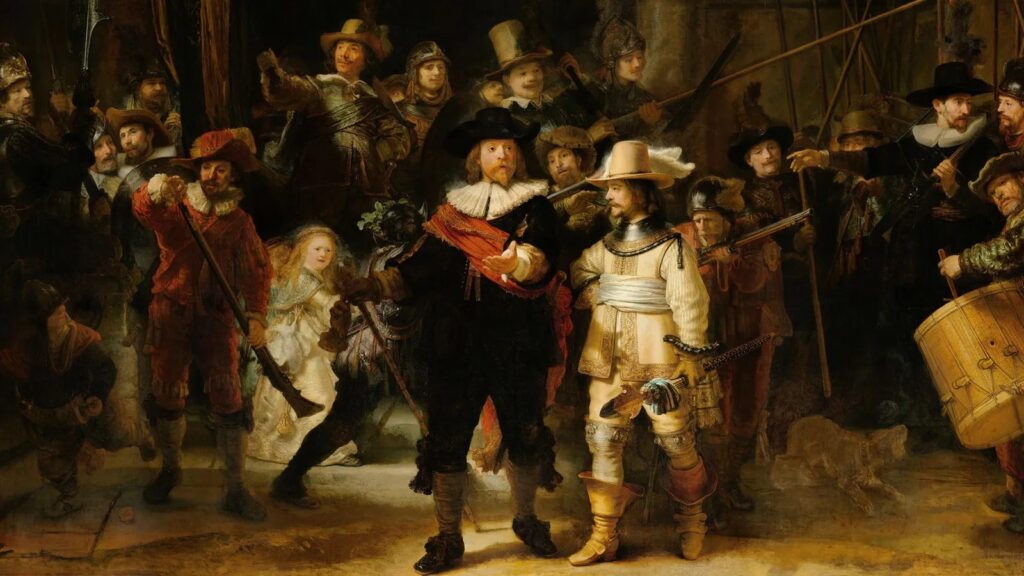Rembrandt History
Rembrandt is one of the most celebrated artists in the history of Western art. His life and work are a testament to his artistic genius and depiction of the human condition. Rembrandt’s journey as an artist was marked by innovation, emotional depth, and a lifelong commitment to perfecting his craft and is truly one of our favorite Great Artists.
Meet Rembrandt
Rembrandt Harmenszoon van Rijn, born on July 15, 1606, in Leiden, Netherlands. His personal life was both successful and tragic. Born into a middle-class family in Leiden, he demonstrated an early aptitude for art and went on to become one of the most celebrated painters of his time. However, he faced financial difficulties and personal loss including the deaths of three of his children and his beloved wife, Saskia. His relationships and personal experiences left a big impact on his art, exhibiting intense emotional depth. Rembrandt’s ability to channel his experiences into his art is a testament to his enduring legacy as a Great Artist.
Why Rembrandt is a Great Artist
Master of Light and Shadow
Rembrandt was a master of chiaroscuro, the use of contrasts between light and dark to create a sense of volume. His ability to manipulate light and shadow gave his paintings an unparalleled depth and realism, earning him the nickname “The Master of Light and Shadow.”
Emotional Depth
Rembrandt’s portraits and historical scenes are known for their emotional depth and realism. He had an uncanny ability to capture the true essence of his subjects, revealing their character and emotions with remarkable precision.
Innovation
Throughout his career, Rembrandt was unafraid to experiment with techniques and materials. He constantly pushed the boundaries of traditional painting, resulting in a diverse body of work that includes etchings, engravings, and paintings. His willingness to take risks and embrace innovation set him apart as an artist during his time.
Capturing Humans
Rembrandt’s works often depict ordinary people, making them relatable to a wide audience. He had a knack for finding the humanity in his subjects, whether they were beggars, merchants, or biblical figures. This ability to connect with the human experience was an incredible skill.
Famous Works of Art in Rembrandt History
Rembrandt’s legacy is defined by a plethora of iconic works, but here are a few that stand out:

“The Night Watch” (1642)

“Self-Portrait with Two Circles” (c. 1665)

“The Jewish Bride” (c. 1665-1669)
What We Can Learn from Rembrandt History
Rembrandt’s life and art offer valuable lessons for artists and art enthusiasts. His mastery of chiaroscuro teaches how manipulating light and shadows can create an atmosphere in art. Furthermore, his ability to convey emotions in his subjects serves as a reminder that art has the power to evoke emotions and connect with people. Rembrandt’s fearless innovation and willingness to push the boundaries of traditional art forms encourage us to get creative in our own art. Rembrandt is truly a Great Artists, and we’re thankful for his innovations for artists for years to come.
Laurie White
Founder of Great Artist Program
As a mom of seven, and educator for over three decades, Laurie White loves to bring visual art education to the home and classroom. She believes that everyone is an artist and everyone can learn how to draw. By studying, copying, and learning from the great artists of the past, we can develop the great artists of the future.
Source:
The Night Watch: https://www.bbc.com/culture/article/20190214-does-rembrandts-the-night-watch-reveal-a-murder-plot
Self Portrait with Two Circles: https://www.wsj.com/articles/masterpiece-rembrandts-self-portrait-with-two-circles-1414187690
The Jewish Bride: https://en.wikipedia.org/wiki/The_Jewish_Bride


Recent Comments